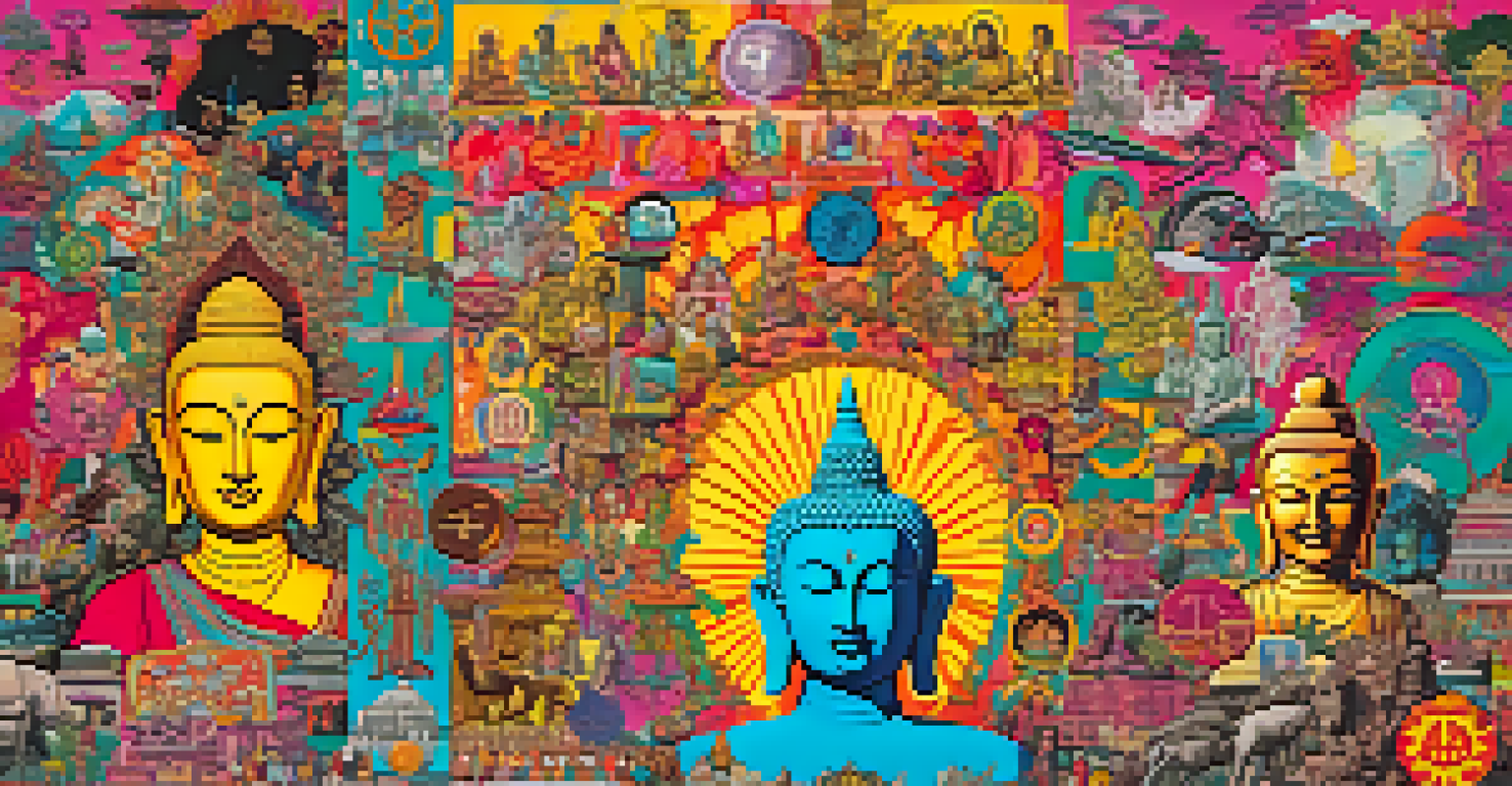Psychedelic Revolution: Shaping Anti-War Movements of the 70s

Introduction to the Psychedelic Revolution
The Psychedelic Revolution of the 1960s and 70s was a cultural wave that transformed society's views on consciousness, spirituality, and personal freedom. Fueled by substances like LSD and psilocybin mushrooms, this movement encouraged exploration beyond conventional boundaries. It became a catalyst for change, influencing everything from art to politics, especially in the context of the Vietnam War.
The mind is everything. What you think you become.
As young people experimented with these mind-altering substances, they began to perceive the world differently. This shift in perspective often led to a growing discontent with the status quo, including the government's involvement in the Vietnam War. The experiences shared in communal settings, like music festivals and underground gatherings, helped foster a sense of unity and purpose among participants.
Thus, the psychedelic experience was not just about individual enlightenment; it became a collective movement aimed at challenging the existing societal norms. This laid the groundwork for a robust anti-war sentiment that resonated deeply within youth culture during the 1970s.
Psychedelics and Political Activism
Psychedelics played a significant role in shaping political activism during the 70s, particularly among the youth. Many activists found that these substances enhanced their ability to empathize and connect with others, fostering a deep sense of solidarity with those suffering from war. This newfound compassion often translated into action, as individuals felt compelled to advocate for peace and justice.

Furthermore, the experiences induced by psychedelics often led to radical rethinking of traditional beliefs about authority and government. People began to question the motives behind the Vietnam War, leading to a surge in protests and demonstrations. Events like the Woodstock Festival became symbolic gatherings that showcased the anti-war movement's spirit, merging music, art, and activism.
Psychedelics Fueled Political Activism
The use of psychedelics during the 1960s and 70s fostered empathy and solidarity among youth, driving them to actively protest against the Vietnam War.
Notably, figures like Timothy Leary encouraged the use of psychedelics as a means to enhance consciousness and challenge oppressive systems. This philosophy resonated with many who participated in anti-war protests, creating a unique blend of spirituality and activism that characterized the era.
The Role of Music in the Movement
Music served as the heartbeat of the psychedelic revolution and the anti-war movement. Artists like Joan Baez, Bob Dylan, and Jefferson Airplane penned songs that resonated with the sentiments of a generation disillusioned by war. Their lyrics often conveyed powerful messages about peace, love, and the desire for change, acting as anthems for anti-war demonstrations.
We are the ones we’ve been waiting for.
The interplay between music and psychedelics created an atmosphere where people could freely express their thoughts and feelings. Concerts and festivals became safe spaces for individuals to gather, share experiences, and discuss their visions for a peaceful future. This communal experience was as much about enjoying music as it was about fostering a collective identity focused on anti-war sentiments.
As people danced and celebrated together, the music echoed the ideals of the movement, reinforcing the belief that love and understanding could triumph over violence and hatred. This synergy between music and activism helped galvanize the anti-war movement and spread its message far and wide.
Counterculture and Its Impact on Society
The psychedelic revolution gave rise to a vibrant counterculture that rejected mainstream values in favor of peace, love, and communal living. This movement emphasized alternative lifestyles, such as communal living and sustainable agriculture, as a response to the destructive nature of war. In many ways, it created a blueprint for future social movements, emphasizing grassroots activism and community engagement.
As individuals embraced these countercultural ideals, they also sought to redefine their relationship with authority and the government. This shift in mindset was evident in the increasing number of protests and rallies that challenged the Vietnam War and the broader military-industrial complex. The counterculture fostered a spirit of rebellion that resonated with many who felt powerless against the government's decisions.
Music as the Movement's Anthem
Music became a powerful vehicle for expressing anti-war sentiments, uniting individuals through shared experiences at concerts and festivals.
Ultimately, the counterculture movement catalyzed significant societal changes, influencing everything from fashion to education. This legacy of questioning authority and advocating for peace continues to inspire movements today, showcasing the enduring impact of the psychedelic revolution.
Influence of Eastern Philosophies
The psychedelic revolution was heavily influenced by Eastern philosophies, particularly Buddhism and Hinduism, which emphasize mindfulness and the interconnectedness of all beings. Many individuals sought spiritual enlightenment through psychedelics, using their experiences to explore new dimensions of consciousness. This blending of Eastern thought with Western ideals contributed to a more holistic approach to activism and social change.
As people delved deeper into these philosophies, they began to see the Vietnam War not just as a political issue, but as a moral one. The teachings of compassion and non-violence resonated strongly with anti-war activists, inspiring them to adopt peaceful methods of protest. This spiritual dimension added depth to the movement, encouraging a sense of responsibility towards all living beings.
Moreover, the incorporation of Eastern practices such as meditation and yoga into the counterculture further united individuals in their quest for peace. This fusion of spiritual exploration with political activism created a unique narrative that emphasized love, understanding, and collective action for social change.
Psychedelics in Protest: A New Approach
Psychedelics also introduced a new approach to protest, focusing on non-violent methods and personal transformation. Activists began to understand that changing the world starts with changing oneself. This philosophy encouraged individuals to embrace love and understanding, rather than anger and resentment, as they engaged in anti-war efforts.
Many protests during this time included elements of celebration and creativity, where participants would use art, music, and dance to convey their messages. This approach not only made the protests more inviting but also reinforced the idea that the anti-war movement was about creating a better world, rather than simply opposing the war. The atmosphere was one of hope and possibility, rather than despair.
Legacy of Peace and Consciousness
The psychedelic revolution's ideals of love, peace, and interconnectedness continue to inspire modern social movements and therapeutic research.
Additionally, this new approach to protest emphasized the importance of community and shared experiences. By fostering connections among individuals, the movement became more than just a political stance; it evolved into a way of life that promoted love, peace, and understanding, setting a precedent for future social movements.
Legacy of the Psychedelic Revolution
The legacy of the psychedelic revolution is still felt today, influencing contemporary movements for social justice and environmentalism. The ideals of love, peace, and interconnectedness that emerged during the 70s continue to resonate with modern activists. Many current movements draw inspiration from the anti-war protests of the past, emphasizing grassroots organization and community engagement.
Moreover, the growing acceptance of psychedelics in therapeutic settings has sparked renewed interest in their potential benefits. Research into the therapeutic effects of substances like psilocybin and MDMA is gaining momentum, further bridging the gap between the revolutionary past and present-day applications. This scientific exploration underscores the idea that psychedelics can contribute positively to individual and societal healing.

Ultimately, the psychedelic revolution not only shaped the anti-war movements of the 70s but also laid the groundwork for ongoing dialogues about consciousness, spirituality, and social change. As we continue to navigate complex societal issues, the lessons from this era remind us of the power of collective action and the importance of compassion in the quest for a better world.